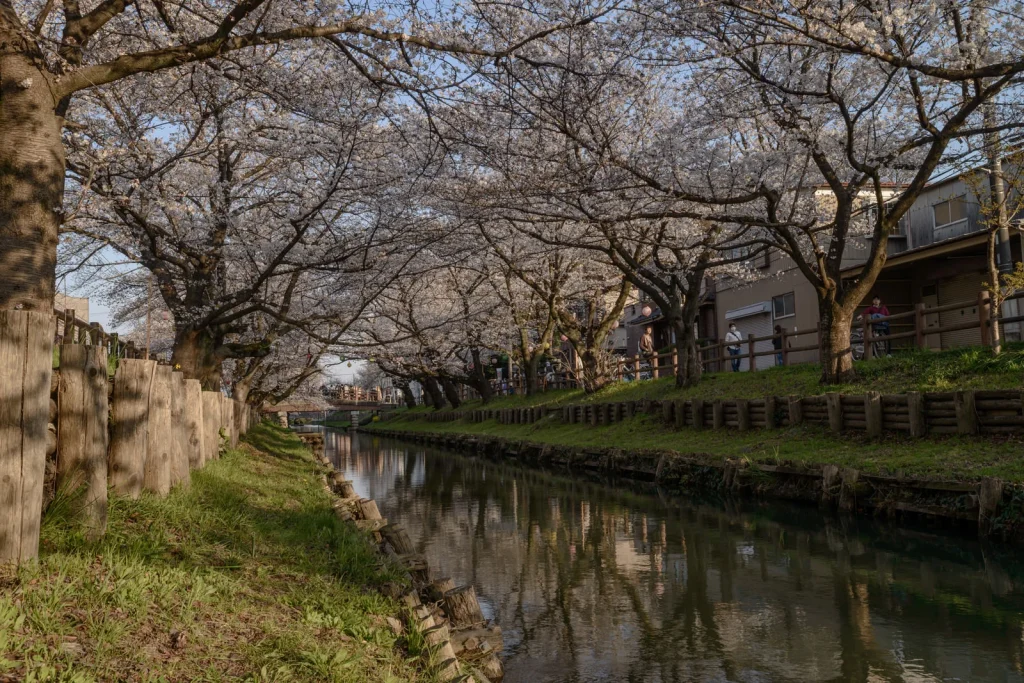Nestled in the Kanto region of Japan, Saitama Prefecture is a cultural and natural haven waiting to be explored.
From the historic treasures of Kawagoe to the tranquil beauty of Chichibu, Saitama offers a diverse range of experiences.
In this comprehensive guide, we will embark on a detailed journey through Saitama, unraveling specific attractions, savoring local delicacies, and immersing ourselves in the unique charm that defines this captivating region.
Allure of Saitama

- Kawagoe: Edo Atmosphere and Kurazukuri Streetscape: Kawagoe, often referred to as “Little Edo,” transports visitors back in time with its well-preserved kurazukuri (clay-walled warehouse) streetscape. The iconic Toki no Kane, or Bell of Time, chimes throughout the day, enhancing the Edo period atmosphere. Kurazukuri Zone, with its historic warehouses, offers a nostalgic stroll through Japan’s past.
- The Time-Honored Kawagoe Hikawa Shrine: Kawagoe Hikawa Shrine, dating back over 1500 years, stands as a spiritual oasis amidst the bustling streets of Kawagoe. The picturesque red torii gates and the sacred Shibarare Jizo add to the serene ambiance. The annual Hikawa Shrine Grand Festival, held in October, features vibrant processions and traditional performances.
- Chichibu: Nature Retreat and Seibu Chichibu Kogen Park: Chichibu, surrounded by mountains and lush greenery, invites visitors to experience the beauty of nature. Seibu Chichibu Kogen Park, with its vast flower fields and recreational activities, provides a perfect setting for family outings. The Chichibu Muse Park offers panoramic views of the landscape, especially during cherry blossom season.
- Chichibu Night Festival: A Spectacle of Floats and Fireworks: The Chichibu Night Festival, held annually in December, is one of Japan’s three major float festivals. Lavishly decorated floats illuminated by lanterns parade through the streets, creating a magical atmosphere. The festival’s fireworks display adds a dazzling finale, making it a must-see cultural event.
- Musashi Ichinomiya Hikawa Shrine: Ancient Roots and Cherry Blossoms: Musashi Ichinomiya Hikawa Shrine, with a history dating back to the 3rd century, is known for its ancient sacred tree, the Shinboku. The shrine’s expansive grounds, surrounded by cherry blossoms in spring, offer a peaceful setting for spiritual reflection. The annual Hikawa Shrine Spring Festival celebrates the beauty of cherry blossoms.
- Mitsumine Shrine: Spiritual Haven Amidst Mountains: Mitsumine Shrine, nestled in the Oku-Chichibu Mountains, is a sacred destination offering a scenic approach through dense forests. The main hall, with its distinctive thatched roof, exudes a mystical atmosphere. The shrine is part of the Chichibu 34 Kannon Sanctuary, providing a spiritual pilgrimage through the region.
- Hanno City: Nature Trails and Maruki Gallery for the Hiroshima Panels: Hanno City, surrounded by mountains and forests, offers nature trails and outdoor activities. The Maruki Gallery, dedicated to the Hiroshima Panels, showcases powerful anti-war artworks. The gallery’s serene setting, surrounded by nature, enhances the emotional impact of the art.
- Saitama Railway Museum: Journey Through Railway History: The Saitama Railway Museum, located in Omiya, is a haven for railway enthusiasts and families alike. The museum features a vast collection of historic trains, interactive exhibits, and a driving simulator. The outdoor exhibition area allows visitors to explore trains from different eras, creating a nostalgic journey through railway history.
- Gyoda City: Historical Edo Townscape and Shodenzan Kangi-in Temple: Gyoda City boasts a well-preserved Edo period townscape, offering a glimpse into the past. The Shodenzan Kangi-in Temple, with its expansive wooden veranda and beautiful garden, provides a tranquil escape. Gyoda’s annual Koedo Kawagoe Spring Festival celebrates the city’s Edo heritage with traditional performances and parades.
- Soka Matsubara: Coastal Beauty and Pine-Lined Strolls: Soka Matsubara, a coastal area lined with pine trees, offers a scenic escape from urban life. The serene atmosphere and walking paths along the coast provide an opportunity for relaxation. The area is particularly popular during sunset, offering breathtaking views of the sun sinking below the horizon.
- Saitama’s Local Delicacies: Culinary Adventures Await: Saitama’s culinary scene is a celebration of local flavors and traditional dishes. The region is renowned for its Nagatoro Iwadatami, a type of unagi (grilled eel) served on flat river stones. Hanno’s Tororo Soba, featuring grated yam on buckwheat noodles, is a local specialty known for its unique texture and flavors.Additionally, Saitama is famous for its Sayama Tea, a high-quality green tea produced in the Sayama region. The tea fields, surrounded by lush greenery, offer a picturesque setting for tea enthusiasts to explore and savor the rich flavors of locally grown tea leaves.
- Okegawa Inari Shrine: Foxes and Red Gates: Okegawa Inari Shrine, known for its numerous fox statues and vermilion torii gates, creates a vibrant and mystical atmosphere. The shrine’s annual Okegawa Fox Parade, held in November, features lively processions and traditional performances, attracting visitors from near and far.
Conclusion:
Saitama Prefecture, with its diverse landscapes, cultural treasures, and delectable cuisine, stands as a destination that invites travelers to explore the essence of Japan.
From the Edo charm of Kawagoe to the natural retreats of Chichibu, each destination within Saitama offers a unique and immersive experience.
As you savor the flavors of Nagatoro Iwadatami and immerse yourself in the rich history of Hikawa Shrine, Saitama promises an unforgettable journey that celebrates the dynamic and welcoming nature of this captivating prefecture.



コメント